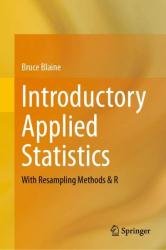 Название: Introductory Applied Statistics: With Resampling Methods & R
Название: Introductory Applied Statistics: With Resampling Methods & RАвтор: Bruce Blaine
Издательство: Springer
Год: 2023
Страниц: 197
Язык: английский
Формат: pdf (true), epub
Размер: 27.8 MB
Includes data analytic examples in R.
This book offers an introduction to applied statistics through data analysis, integrating statistical computing methods. It covers robust and non-robust descriptive statistics used in each of four bivariate statistical models that are commonly used in research: ANOVA, proportions, regression, and logistic. The text teaches statistical inference principles using resampling methods (such as randomization and bootstrapping), covering methods for hypothesis testing and parameter estimation. These methods are applied to each statistical model introduced in preceding chapters.
Data analytic examples are used to teach statistical concepts throughout, and students are introduced to the R packages and functions required for basic data analysis in each of the four models. The text also includes introductory guidance to the fundamentals of data wrangling, as well as examples of write-ups so that students can learn how to communicate findings. Each chapter includes problems for practice or assessment. Supplemental instructional videos are also available as an additional aid to instructors, or as a general resource to students.
This book is intended for an introductory or basic statistics course with an applied focus, or an introductory analytics course, at the undergraduate level in a two-year or four-year institution. This can be used for students with a variety of disciplinary backgrounds, from business, to the social sciences, to medicine. No sophisticated mathematical background is required.
This book doesn’t organize chapters by statistical method (e.g., a t-test chapter), as is common in introductory statistics books. Rather, descriptive and inferential statistics are organized around the type of study design that produced the data. The framework includes four common bivariate models:
• ANOVA model (categorical X/numeric Y)
• Proportions model (categorical X/categorical Y)
• Regression model (numeric X/numeric Y)
• Logistic model (numeric X/categorical Y)
To properly and fully understand statistical inference (and not merely its null hypothesis testing component), students of statistics must learn how study design elements like random sampling, manipulated versus observed predictor variables, and control of alternative explanations affect the interpretation of and conclusions about statistical procedures.
• Statistical inference taught with resampling methods. You can draw a straight line between Tukey’s vision for statistics and modern simulation-based statistical inference. In this book, students learn and use randomization (aka permutation) and bootstrapping methods for hypothesis testing and parameter estimation. Resampling methods are intuitive and, once understood, apply logically and consistently to inferential problems across study design type. Resampling methods also free us from the limitations of theoretical probability distributions, particularly with regard to parametric assumptions. Finally, the computing skills needed to use randomization and bootstrapping are within the reach of the introductory statistics or data science student.
• Statistical computing with R. This book incorporates data analytic examples in R into each chapter, and assumes no prior experience with R in students. Files containing R functions and code are provided for each chapter.
The book assumes that students will use R and RStudio on a regular basis, and have access to those programs outside of class for homework and assignments. No prior computing or programming experience is assumed in students, but developing students’ statistical computing skills in R is assumed to be a learning goal of the course, so course time should be allotted for that. RStudio Cloud (aka Posit Cloud) is an excellent environment to work in: it is widely accessible outside of class and doesn’t require local installs and updates. For instructors wanting students to use R Markdown for assignments, RStudio Cloud also meshes well with R Markdown.
For instructors, some prior experience with the R language and environment is necessary, but your R skills need not be deep or extensive, especially if you have colleagues to whom you can turn with questions and support. If you are new to R or are just learning, teaching with R is the best way to learn the language.
Contents:
Скачать Introductory Applied Statistics: With Resampling Methods & R
